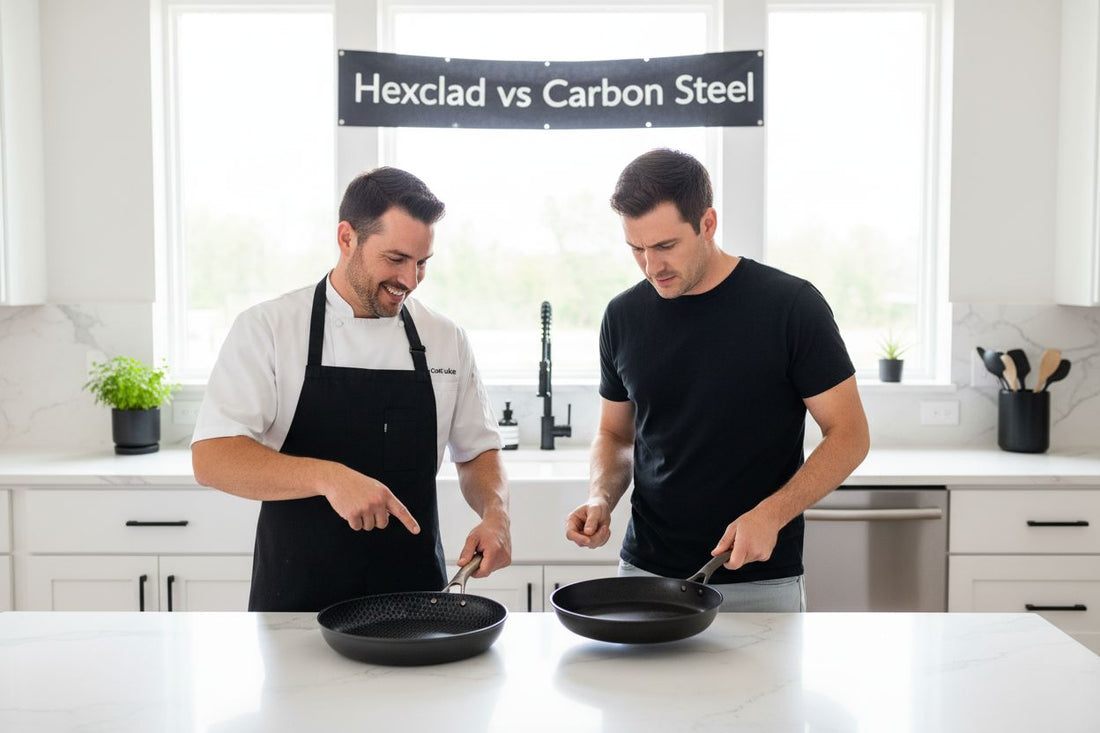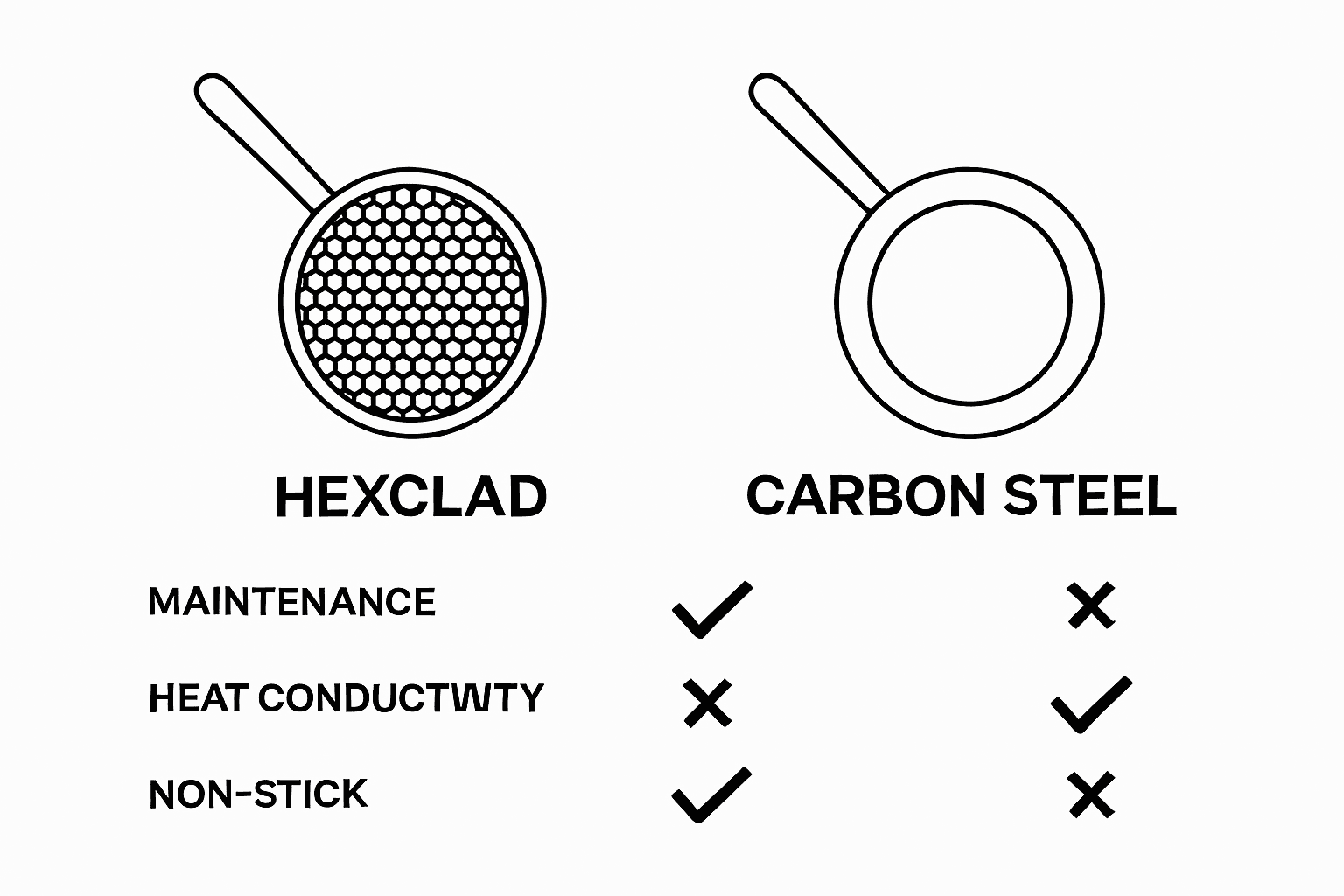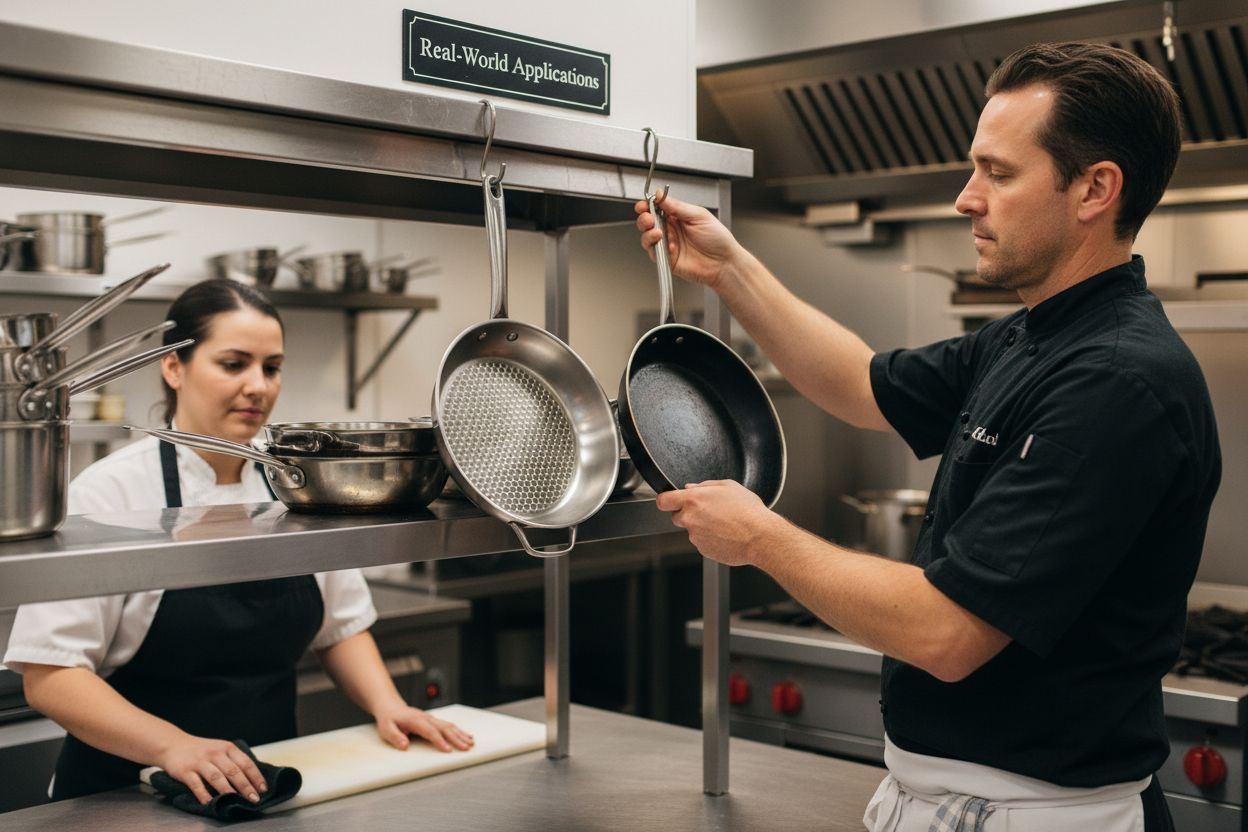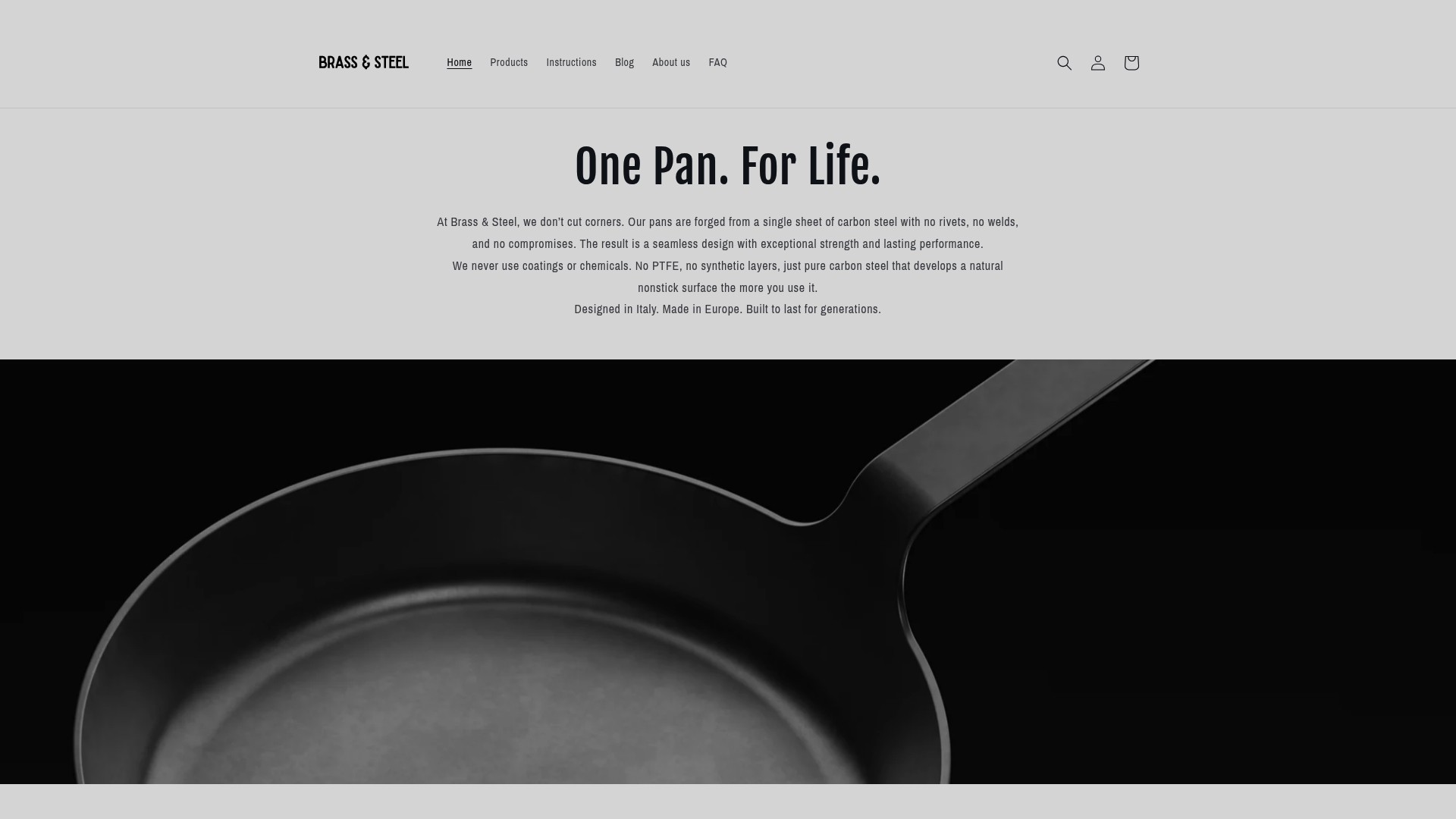
Understanding Hexclad vs Carbon Steel for Cooking
Share
Hexclad cookware is changing kitchens everywhere, combining science and style with its hybrid pan design. Most people still think nothing beats the classic flair of carbon steel, the material that professional chefs have trusted for centuries. But the shock is that Hexclad’s laser-etched surface gives you immediate nonstick performance and easier cleaning straight out of the box, something carbon steel simply cannot match until it is seasoned for months.
Table of Contents
- What Is Hexclad And How Does It Differ From Carbon Steel?
- The Importance Of Material Choice In Culinary Performance
- How Hexclad And Carbon Steel Conduct Heat
- Durability And Maintenance: Which Material Lasts Longer?
- Real-World Applications: When To Use Hexclad Vs Carbon Steel In The Kitchen
Quick Summary
| Takeaway | Explanation |
|---|---|
| Hexclad combines stainless steel and aluminium. | This hybrid construction offers both durability and nonstick performance compared to traditional materials like carbon steel. |
| Hexclad requires less maintenance than carbon steel. | Unlike carbon steel, which needs regular seasoning, Hexclad’s surface is designed for easy cleaning and immediate nonstick use. |
| Carbon steel excels in heat conductivity. | It heats quickly and evenly, making it ideal for high-heat cooking techniques such as searing and stir-frying. |
| Hexclad’s unique design aids in food release. | The hexagonal laser-etched surface allows for better food release, enhancing the cooking experience and making cleaning simpler. |
| Choose cookware based on cooking style. | Hexclad is versatile for everyday cooking, while carbon steel is suited for professional kitchens requiring precision and rapid heat adjustments. |
What is Hexclad and How Does it Differ from Carbon Steel?
Hexclad represents an innovative cookware technology that blends traditional cooking surface design with modern manufacturing techniques. Unlike carbon steel, which has been used for centuries, Hexclad introduces a hybrid approach to pan construction that aims to address some limitations of conventional cookware materials.
The Unique Construction of Hexclad
Hexclad is characterized by its distinctive manufacturing process that combines stainless steel and aluminium with a unique hexagonal laser-etched surface pattern. This design creates a tri-layer construction where the hexagonal laser-etched pattern sits atop a stainless steel base, creating a surface that looks and performs differently from traditional carbon steel.
Key characteristics of Hexclad include:
- A laser-etched hexagonal pattern that creates raised stainless steel ridges
- Combination of stainless steel and aluminium materials
- Designed to provide both nonstick performance and durability
According to Consumer Reports, the unique surface design allows for better food release and easier cleaning compared to traditional carbon steel pans.
Performance Differences Between Hexclad and Carbon Steel
While carbon steel is known for its natural seasoning capabilities and exceptional heat conductivity, Hexclad offers a different approach to cooking performance. Carbon steel requires manual seasoning and develops a natural nonstick patina over time, whereas Hexclad comes with a hybrid surface that provides immediate nonstick properties.
The primary distinctions include:
- Heat Conductivity: Carbon steel typically offers superior heat distribution
- Maintenance: Hexclad requires less maintenance compared to carbon steel
- Initial Nonstick Properties: Hexclad provides immediate nonstick performance
Chefs and home cooks considering Hexclad should understand these fundamental differences. While carbon steel offers traditional cooking experience and develops character with use, Hexclad provides a more modern, low-maintenance alternative.
To provide a clear comparison between Hexclad and carbon steel cookware, the following table summarises their key characteristics, advantages, and performance differences as discussed in the article.
| Feature/Aspect | Hexclad | Carbon Steel |
|---|---|---|
| Construction | Tri-layer: stainless steel, aluminium, laser-etched hexagons | Single-piece iron-carbon alloy, smooth surface |
| Nonstick Properties | Immediate, due to hybrid surface | Develops over time with seasoning |
| Heat Conductivity | Moderately even, aided by aluminium core | Exceptionally responsive and direct |
| Maintenance Requirements | Low, easy to clean, no seasoning needed | Requires regular seasoning and careful cleaning |
| Durability | Resistant to warping, robust hybrid construction | Can last generations with proper care and seasoning |
| Typical Use | Home cooking, multipurpose | Professional cooking, high-heat tasks, searing, stir-frying |
| Ease of Cleaning | High, thanks to etched pattern | Moderate, seasoning may be affected if not cleaned correctly |
 Read more about carbon steel maintenance in our comprehensive guide.
Read more about carbon steel maintenance in our comprehensive guide.
The Importance of Material Choice in Culinary Performance
Cookware material selection is far more than a mere aesthetic decision. It fundamentally impacts cooking performance, heat distribution, durability, and ultimately the quality of food prepared. Professional chefs and passionate home cooks understand that the right material can transform cooking from a basic task to a precise culinary art.
Heat Conductivity and Thermal Performance
Different cookware materials conduct and retain heat uniquely, which directly influences cooking outcomes. Thermal conductivity determines how quickly and evenly heat spreads across the cooking surface. Materials like carbon steel and copper are prized for their exceptional heat responsiveness, allowing chefs to make minute temperature adjustments with remarkable precision.
Key thermal characteristics include:
- Rapid heat transfer and temperature control
- Even heat distribution across cooking surface
- Ability to maintain consistent temperatures
According to Science of Cooking, thermal conductivity significantly impacts cooking techniques and final food texture.
Durability and Long-Term Performance
The longevity and performance of cookware depend critically on material properties. Carbon steel, for instance, develops a natural seasoning that improves with use, creating a near nonstick surface through careful maintenance. In contrast, materials like aluminium and stainless steel offer different durability profiles.
Important durability considerations involve:
- Resistance to warping and deformation
- Ability to withstand high cooking temperatures
- Maintenance requirements and potential degradation
Professional kitchens prioritize cookware that maintains performance over hundreds of cooking cycles. Explore our comprehensive guide to professional kitchen essentials to understand how material selection impacts culinary equipment choices.
How Hexclad and Carbon Steel Conduct Heat
Heat conductivity is a critical factor in cookware performance, determining how efficiently and evenly temperature transfers across a cooking surface. Both Hexclad and carbon steel exhibit unique thermal characteristics that significantly influence cooking techniques and outcomes.
Thermal Composition and Structure
Carbon steel is renowned for its exceptional heat conductivity due to its pure iron and carbon composition. The material conducts heat rapidly and uniformly, allowing precise temperature control. Thermal diffusivity enables carbon steel to respond quickly to temperature changes, making it a favourite among professional chefs who require immediate heat adjustments.
Hexclad, by contrast, utilises a tri-layer construction combining stainless steel, aluminium, and a unique hexagonal surface pattern. This hybrid approach creates different thermal properties compared to traditional carbon steel.
Key thermal transfer characteristics include:
- Rapid heat distribution across cooking surface
- Ability to maintain consistent temperatures
- Responsiveness to heat source changes
According to Scientific American, material composition dramatically influences cooking performance and food preparation techniques.
Comparative Heat Performance
While carbon steel offers direct, aggressive heat transfer, Hexclad provides a more moderated thermal experience. The aluminium core in Hexclad helps distribute heat more evenly, reducing potential hot spots that can cause uneven cooking.
Important heat conductivity considerations:
- Carbon Steel: Faster heat responsiveness
- Hexclad: More uniform heat distribution
- Temperature Control: Varies based on specific cooking technique
Learn more about carbon steel induction cooking techniques to understand how material properties influence cooking performance.
Durability and Maintenance: Which Material Lasts Longer?
Cookware durability represents a critical consideration for both professional chefs and home cooks. The longevity of a cooking surface directly impacts its performance, maintenance requirements, and overall value proposition. Carbon steel and Hexclad offer distinct approaches to durability that reflect their unique material compositions and manufacturing techniques.
Structural Resilience and Wear Resistance
Carbon steel is renowned for its exceptional durability and potential to last generations when properly maintained. The material develops a natural seasoning over time that not only enhances its nonstick properties but also protects the underlying metal from corrosion. Structural integrity becomes progressively stronger with careful use and consistent maintenance.
Hexclad, by comparison, utilises a hybrid construction that combines multiple material layers. The stainless steel and aluminium core provides robust resistance to warping and structural deformation.
Key durability considerations include:
- Resistance to mechanical stress
- Capacity to withstand high cooking temperatures
- Long-term performance consistency
- Protection against surface degradation
The New York Times confirms that properly maintained carbon steel pans can endure decades of intensive culinary use.
Maintenance Requirements and Longevity
The maintenance approach significantly influences the lifespan of cookware. Carbon steel demands more deliberate care, including regular seasoning and careful cleaning to prevent rust. Hexclad offers a more low-maintenance alternative with its hybrid surface design.
Important maintenance factors:
- Carbon Steel: Requires periodic seasoning
- Hexclad: More forgiving cleaning protocol
- Surface Protection: Varies based on usage techniques
Professional kitchens prioritise cookware that balances durability with practical maintenance requirements.
The following table offers a side-by-side summary of durability and maintenance factors for Hexclad and carbon steel, highlighting practical considerations already covered in the article.
| Durability Factor | Hexclad | Carbon Steel |
|---|---|---|
| Structural Resilience | High, due to hybrid layer construction | High when maintained, develops strength over time |
| Resistance to Warping | Excellent | Very good, but may warp if overheated when empty |
| Surface Protection | Stainless steel ridges protect hybrid surface | Seasoning protects metal from corrosion |
| Maintenance Level | Low – easy to clean, minimal upkeep | High – requires seasoning, sensitive to moisture |
| Longevity | Long-lasting with minimal fuss | Can last for decades with ongoing attentive care |
| Cleaning Protocol | Forgiving, dishwasher safe in many cases | Hand wash only, avoid harsh detergents |
| Explore our comprehensive guide to professional cookware maintenance to understand material-specific care strategies. |
Real-World Applications: When to Use Hexclad vs Carbon Steel in the Kitchen
Selecting the right cookware requires understanding the unique strengths of different materials. Professional chefs and home cooks must consider specific cooking techniques, ingredient types, and desired culinary outcomes when choosing between Hexclad and carbon steel.
Professional Cooking Scenarios
In professional kitchen environments, carbon steel remains the preferred choice for high-heat cooking techniques. Its rapid heat responsiveness and ability to develop a natural nonstick surface make it ideal for techniques like searing meats, creating perfect caramelisation, and managing precise temperature control.
Ideal carbon steel applications include:
- High temperature searing of proteins
- Rapid temperature adjustments
- Professional restaurant line cooking
- Techniques requiring immediate heat transfer
America’s Test Kitchen highlights carbon steel as the professional chef’s preferred material for demanding cooking scenarios.
Home Cooking and Versatility
Hexclad offers superior versatility for home cooks seeking a low-maintenance, multipurpose cooking surface. Its hybrid construction provides consistent heat distribution and easier cleaning, making it an excellent choice for everyday cooking tasks that do not require extreme heat manipulation.
Key considerations for home cooking include:

- Ease of cleaning
- Compatibility with various cooking surfaces
- Reduced maintenance requirements
- Consistent cooking performance
Explore our comprehensive guide comparing different cookware materials to understand the nuanced differences between cooking surfaces.
Take Control of Your Cooking with Authentic Carbon Steel
Choosing between Hexclad and carbon steel means understanding what really matters in your kitchen. If you feel frustrated with cookware that wears out quickly or struggles with true heat performance, you are not alone. Many cooks want the beauty of easy cleaning but refuse to compromise on flavour, longevity, or the satisfaction of a perfectly developed seasoning. The article has shown that carbon steel offers unique advantages in durability and heat control, building natural nonstick character over time and elevating every dish — which is exactly what passionate cooks desire.
Explore our Carbon Steel Collection for handcrafted pans that empower your cooking through single-piece forging and engineering precision.

Discover how a genuine carbon steel pan can transform your experience, making every sear and sauté more rewarding. Visit https://brass-steel.com now and invest in cookware that will serve you for years. The difference is best felt in your own kitchen — join the Brass & Steel community of cooks who demand heirloom quality and uncompromising performance.
Frequently Asked Questions
What is Hexclad cookware?
Hexclad cookware is an innovative type of cookware that features a hybrid design combining stainless steel and aluminium, with a unique hexagonal laser-etched surface pattern that enhances food release and cleaning.
How does Hexclad differ from carbon steel pans?
Hexclad offers immediate nonstick properties and requires less maintenance compared to carbon steel, which requires manual seasoning for optimal performance. Hexclad also features a tri-layer construction that provides even heat distribution, while carbon steel is known for its exceptional heat conductivity.
Which cookware is more durable: Hexclad or carbon steel?
Both materials are durable, but they differ in maintenance. Carbon steel can last for generations with proper seasoning and care, while Hexclad’s hybrid construction resists warping and is easier to maintain, making it a practical choice for everyday cooking.
When should I use Hexclad versus carbon steel in cooking?
Hexclad is ideal for everyday cooking and versatile use in the home kitchen, offering consistent performance with minimal maintenance. In contrast, carbon steel is better suited for high-heat cooking techniques, such as searing and rapid temperature adjustments in professional setups.